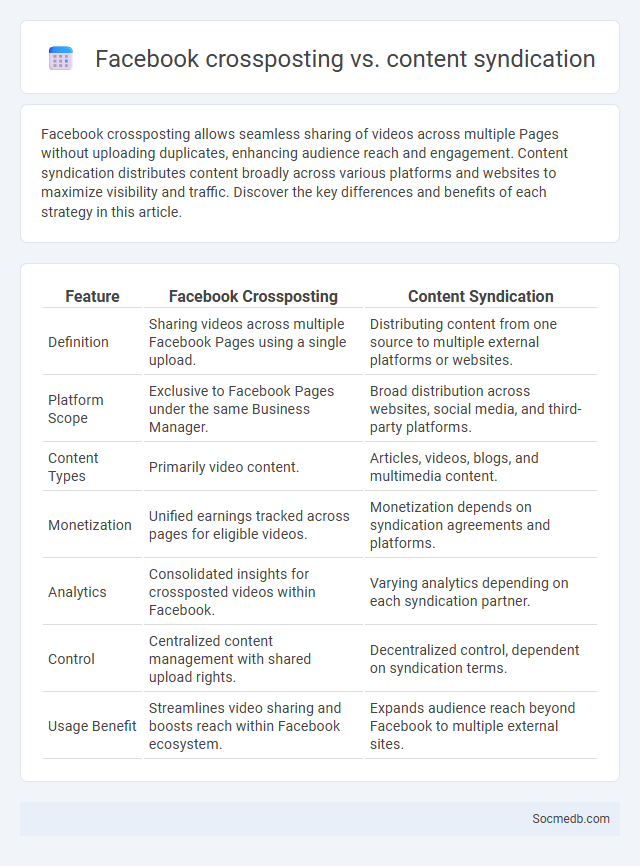
Photo illustration: Facebook Crossposting vs Content Syndication
Facebook crossposting allows seamless sharing of videos across multiple Pages without uploading duplicates, enhancing audience reach and engagement. Content syndication distributes content broadly across various platforms and websites to maximize visibility and traffic. Discover the key differences and benefits of each strategy in this article.
Table of Comparison
| Feature | Facebook Crossposting | Content Syndication |
|---|---|---|
| Definition | Sharing videos across multiple Facebook Pages using a single upload. | Distributing content from one source to multiple external platforms or websites. |
| Platform Scope | Exclusive to Facebook Pages under the same Business Manager. | Broad distribution across websites, social media, and third-party platforms. |
| Content Types | Primarily video content. | Articles, videos, blogs, and multimedia content. |
| Monetization | Unified earnings tracked across pages for eligible videos. | Monetization depends on syndication agreements and platforms. |
| Analytics | Consolidated insights for crossposted videos within Facebook. | Varying analytics depending on each syndication partner. |
| Control | Centralized content management with shared upload rights. | Decentralized control, dependent on syndication terms. |
| Usage Benefit | Streamlines video sharing and boosts reach within Facebook ecosystem. | Expands audience reach beyond Facebook to multiple external sites. |
Understanding Facebook Crossposting: Definition and Purpose
Facebook crossposting allows you to publish a single video across multiple Pages without uploading multiple copies, streamlining content distribution and maintaining consistent engagement metrics. This feature is essential for businesses and creators managing several Facebook Pages, ensuring the same post reaches diverse audiences efficiently while optimizing video views and analytics. Understanding crossposting enhances your social media strategy by maximizing reach and simplifying content management on Facebook.
What is Content Syndication? Key Concepts Explained
Content syndication is the process of republishing or distributing content from one source across multiple platforms to reach a broader audience and increase visibility. Key concepts include the original content creator retaining ownership, while syndication partners gain permission to republish the content, often with attribution and links back to the source. Effective content syndication boosts SEO, drives traffic, and enhances brand authority by leveraging diverse social media channels and websites.
Crossposting Beyond Facebook: Broader Strategies
Crossposting beyond Facebook involves sharing content across multiple platforms like Instagram, Twitter, LinkedIn, and TikTok to maximize reach and engagement. Utilizing platform-specific features and tailoring messages enhances visibility and drives diverse audience interaction. Your social media strategy thrives by integrating varied channels, ensuring consistent branding and expanded influence.
Facebook Crossposting vs Content Syndication: Core Differences
Facebook crossposting allows content creators to share videos across multiple Facebook Pages they manage without uploading multiple copies, enhancing reach while maintaining unified insights and interactions. Content syndication distributes content through third-party platforms or websites to expand audience exposure beyond the original site, often involving repackaging or licensing content. The core difference lies in crossposting being platform-specific for efficient multi-page sharing within Facebook, whereas content syndication targets broader external distribution to diverse platforms.
Pros and Cons of Facebook Crossposting for Marketers
Facebook crossposting allows marketers to efficiently share video content across multiple Facebook Pages, boosting reach and engagement without the need to upload videos repeatedly. This feature streamlines content distribution, saving time and maintaining consistent messaging across brand channels. However, crossposting can lead to decreased organic reach due to algorithm limitations and may cause audience overlap, resulting in reduced engagement per post.
Advantages and Disadvantages of Content Syndication
Content syndication on social media amplifies Your brand's reach by distributing content across multiple platforms, driving increased traffic and improving SEO performance. It saves time and resources by repurposing existing content while maintaining consistent messaging to diverse audiences. However, content syndication risks duplicate content penalties by search engines and may reduce engagement if the audience encounters the same material repeatedly.
Platform Guidelines: Facebook Crossposting vs Content Syndication
Facebook crossposting allows you to share videos across multiple Facebook Pages you manage without re-uploading, optimizing reach while maintaining video analytics and viewer engagement within the platform's ecosystem. Content syndication involves distributing your content across various external websites or social media channels, expanding exposure but often diluting direct control and analytic precision. Understanding Facebook's platform guidelines helps ensure your crossposted videos comply with copyright and community standards, preserving your account standing and maximizing content impact.
SEO Implications: Crossposting vs Content Syndication
Crossposting on social media can lead to duplicate content issues that negatively impact SEO rankings by diluting original content authority across multiple platforms. Content syndication, when properly attributed with canonical tags, enhances SEO by driving traffic back to the original source while expanding reach. Effective use of syndicated content increases backlinks and visibility without risking search engine penalties associated with replicated posts.
Best Practices for Crossposting and Syndication Success
Maximize audience reach and engagement by tailoring content to fit each social media platform's unique format and user behavior. Utilize scheduling tools to maintain consistent posting times while avoiding duplicate content penalties by customizing captions and multimedia elements. Leverage analytics to identify high-performing posts and optimize syndication strategies for increased visibility and brand coherence across channels.
Choosing the Right Strategy: Facebook Crossposting or Content Syndication?
Choosing the right strategy between Facebook crossposting and content syndication depends on your audience engagement goals and content distribution preferences. Facebook crossposting allows seamless sharing of videos across multiple Pages to maximize reach within the Facebook ecosystem, while content syndication distributes your content across various external platforms to broaden exposure and drive traffic back to your site. Evaluating audience demographics, content type, and platform algorithms helps determine which approach optimizes visibility and ROI for your social media marketing efforts.
 socmedb.com
socmedb.com